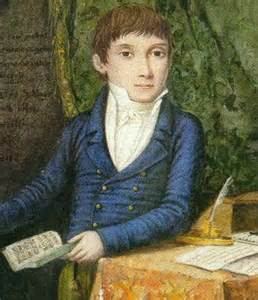The day the music died
 |
| Joseph Kriehuber's 1842 portrait of Gaetano Donizetti |
Donizetti had returned to his native city after a brilliant international career to spend his last days in the Palazzo Scotti in the Città Alta, the upper town.
By then seriously ill, he was looked after by friends in the gracious surroundings of the palazzo until his death. His tomb is in the Basilica di Santa Maria Maggiore, where it is marked by a white, marble monument.
Donizetti has since become acknowledged as the greatest composer of lyrical opera of all time. He was a major influence on Giuseppe Verdi, Giacomo Puccini and other composers who came after him.
Along with Gioachino Rossini and Vincenzo Bellini, he was a leading composer of the bel canto opera style during the first half of the 19th century. Among more than 70 works, his best and most famous operas are considered to be Lucia di Lammermoor, Don Pasquale and L’elisir d’amore.
In Via Sentierone in Bergamo’s lower town there is an elaborate white marble monument to the composer next to Teatro Donizetti, which was renamed in his honour in 1897 on the centenary of his birth.
In Via Sentierone in Bergamo’s lower town there is an elaborate white marble monument to the composer next to Teatro Donizetti, which was renamed in his honour in 1897 on the centenary of his birth.
 |
| Donizetti painted as a schoolboy in Bergamo in the early 19th century |
His first important success came in 1818 with Enrico di Borgogna at the Teatro San Luca, in Venice. Soon afterwards he moved to Naples, taking up residency at the Teatro San Carlo in 1822 at the age of 25. He stayed there until 1844, producing more than three quarters of his work there. In 1830 his Anna Bolena, produced at Teatro alla Scala in Milan, carried his fame abroad and two years later came L’elisir d’amore. The year after that Lucrezia Borgia consolidated his reputation in Milan.
However, more than once he found himself at odds with the censors, and in the 1840s began to spend an increasing amount of time in Paris, where the censorship rules were less strict.
Married in 1828 to Virginia Vasseli, the sister of one of his closest friends in Rome, Donizetti's spirits suffered greatly after her death in 1837, soon after the stillbirth of a son. Indeed, none of their three children survived birth.
His own health began to decline soon after he moved to Paris and it was not only physically but mentally that he deteriorated rapidly, suffering periods of near-insanity due to the loss of his cognitive faculties. It was only because of the devotion of a nephew, Andrea, that he was able to return to Bergamo for his final days.
His own health began to decline soon after he moved to Paris and it was not only physically but mentally that he deteriorated rapidly, suffering periods of near-insanity due to the loss of his cognitive faculties. It was only because of the devotion of a nephew, Andrea, that he was able to return to Bergamo for his final days.
 |
| Donizetti's birthplace in Via Borgo Canale is clearly marked at No 14 |
Donizetti’s Casa Natale (birthplace), is in Via Borgo Canale just outside the walls of the upper town. It has now been declared a national monument and is open free to visitors every weekend. You can still see the well from which the family drew their water and the fireplace where meals were cooked, which would also have been their only source of heating. To reach Donizetti’s birthplace, leave the Città Alta through Porta Sant’Alessandro and go past the station for the San Vigilio funicolare. Via Borgo Canale is the next street on the right and Casa Natale, at number 14, is in the middle of a row of characteristic, tall houses and is marked by a plaque.
Bergamo hotels by Booking.com
Travel tip:
A museum dedicated to Donizetti’s life and career is housed in the former Palazzo Misericordia Maggiore, now a musical institute, in Via Arena in the Città Alta. There are many interesting letters, documents and original scores on display along with the bed he died in and the chair he sat in while staying in Palazzo Scotti towards the end of his life. Donizetti’s tomb can be seen in the Basilica di Santa Maria Maggiore in Piazza Duomo in the Città Alta.
 |
| The bed in which Donizetti spent his final hours in Palazzo Scotti is on display in the museum in Via Arena |
A museum dedicated to Donizetti’s life and career is housed in the former Palazzo Misericordia Maggiore, now a musical institute, in Via Arena in the Città Alta. There are many interesting letters, documents and original scores on display along with the bed he died in and the chair he sat in while staying in Palazzo Scotti towards the end of his life. Donizetti’s tomb can be seen in the Basilica di Santa Maria Maggiore in Piazza Duomo in the Città Alta.
Also on this day:
No comments:
Post a Comment